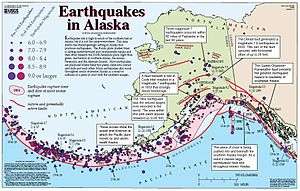Queen Charlotte Fault

The Queen Charlotte Fault is an active transform fault that marks the boundary of the North American and the Pacific Plates. It is Canada's right-lateral strike-slip equivalent to the San Andreas Fault to the south in California. The Queen Charlotte Fault forms a triple junction on its south with the Cascadia subduction zone and the Explorer Ridge (the Queen Charlotte Triple Junction).
The fault is named for the Queen Charlotte Islands (now Haida Gwaii) which lie just north of the triple junction. The Queen Charlotte Fault continues northward along the Alaskan coast where it is called the Fairweather Fault. The two segments are collectively called the Queen Charlotte-Fairweather Fault System.
The fault has been the source of large, very large, and great earthquakes. The study of the Queen Charlotte Fault affords further important information applicable to other similar faults throughout the world.[1]
Significant earthquakes along the fault
| Date | M | Damage | Article |
|---|---|---|---|
| 1929 | ~7 | ||
| 1949 | 8.1 | Landslides, Housing | 1949 Queen Charlotte Islands earthquake |
| 1970 | 7.4 | Landslides | |
| 1990 | 5.3 | Minor | |
| 2001 | 6.3 | Minor | |
| 2004 | 6.8 | Land slippage | |
| 2008 | 6.5 | Minor | |
| 2009 | 6.6 | Minor | |
| 2012 | 7.8 | Hot Spring Island cessation | 2012 Haida Gwaii earthquake |
Four large earthquakes have occurred along the Queen Charlotte Fault within the last hundred years: a magnitude 7 event in 1929, a magnitude 8.1 occurred in 1949 (Canada's largest recorded earthquake since the 1700 Cascadia earthquake) a magnitude 7.4 in 1970 and a magnitude 7.8 on Oct 27 2012
The P nodal focal mechanism for the 1949 earthquake indicates a virtually pure strike-slip movement with a northwest striking nodal plane corresponding to the strike of the fault. The 1970 earthquake did however show a similar strike-slip movement with a small but significant thrust component, consistent with relative plate motion. The 1949 earthquake was larger than the 1906 San Francisco earthquake, causing nearly a 500 kilometer long segment of the Queen Charlotte Fault to break.
A pair of 6.5 magnitude quakes occurred on January 5, 2008 near the southern triple junction, although they do not appear to have occurred directly on the Queen Charlotte Fault.[2]
A 7.8 magnitude quake struck off the western coast of Haida Gwaii at around 8:10pm Pacific Time on Saturday 27 October 2012. This was the biggest quake in Canadian territory since 1949. Aftershocks as large as 6.3 have been reported. A 45-cm tsunami was reported locally. Alerts were sent across the Pacific Basin.[3] This earthquake did not have any major impacts, except for the temporary cessation of the hotsprings on Hotspring Island. The spring seems to have returned to borderline nominal functioning as of July 2014.
Gwaii Haanas superintendent Ernie Gladstone noted the hotspring's recent behavior
- "There is water flowing at the high tide level and five or six feet higher than high tide level now, which is quite warm, probably around 60 degrees. [...]
- "Even in some of the locations where water hasn't yet returned, the ground temperature below the surface is warmer than it is on the surface. So that's encouraging as well."
This quake was remarkable for having been a thrust, and not a strike-slip tremor, more like the mechanism of the Cascadia Subduction Zone to the south.[4] Recent detailed seafloor mapping has revealed the expression of the Queen Charlotte Fault on the seafloor[5] including the truncation of submarine canyons that occur along the continental slope.[6]
See also
References
- ↑ Seismic zones in Western Canada Retrieved on 2015-03-11
- ↑ USGS Earthquake Hazards Program: Earthquake Location: QUEEN CHARLOTTE ISLANDS REGION
- ↑ CBC Newsworld, "7.7 Magnitude Quake Breaking News Special", airdate: 27–28 October 2012
- ↑ "Superquakes, supercycles, and global earthquake clustering", Chris Goldfinger, Yasutaka Ikeda and Robert S. Yeats, EARTH, January 7, 2013.
- ↑ Barrie, J.V., Conway, K., Harris, P.T., 2013. The Queen Charlotte Fault, British Columbia: seafloor anatomy of a transform fault and its influence on sediment processes. Geo-Marine Letters 33, 311–318.
- ↑ Harris, P.T., Barrie, J.V., Conway, K.W., Greene, G.H., 2014. Hanging canyons of Haida Gwaii, British Columbia, Canada: Fault-control on submarine canyon geomorphology along active continental margins. Deep-Sea Research Part II: Topical Studies in Oceanography 104, 83-92.